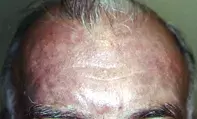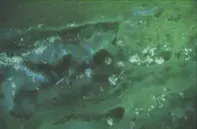What’s the diagnosis?
Progressive facial slate-grey pigmentation

Figure 1. Slate-grey pigmentation on the patient’s forehead.

Figure 2. Bright fluorescent lipofuscin particles in the dermis, seen on skin biopsy under UV light microscopy.
Differential Diagnosis
Minocycline induces a blue-black pigmentation that is often concentrated in areas of inflammation as well as involving the mucous membranes. In skin biopsies the pigment deposits stain positively for iron, and ultrastructural studies reveal electron-dense particles that are not membrane bound.
Tricyclic antidepressants can induce blue to slate-grey pigmentation in sun-exposed sites. Biopsy shows refractile golden brown granules which stain positively for melanin but not for iron. Ultrastructural studies reveal pigment granules in membrane-bound lysosomes.
Silver (argyria) and other heavy metals may induce diffuse slate-blue pigmentation that may extend to mucous membranes. These appear on skin biopsy as dark granules which often outline elastic fibres and are concentrated around the appendages and vessels. Energy dispersive x-rays may be used for specific identification of metals in tissue sections.
Amiodarone-induced pigmentation is the correct diagnosis in this case. It is usually accentuated in sun-exposed skin sites. Amiodarone induces lipofuscin, which is the result of drug-induced phototoxic degeneration of lysosomes. The pigment usually fades when the amiodarone dose is reduced or discontinued. Amiodarone less commonly induces a photosensitivity to sunlight and rarely hair loss, vasculitis or vegetating skin lesions, due to the iodide component of the drug.
A 68-year-old man had noted progressive pigmentation which was confined to his face (Figure 1) and dorsal aspect of his hands. This was asymptomatic and had increased over a period of three years. He had undergone coronary bypass surgery six years previously and had subsequently developed a cardiac arrhythmia, which was managed with digoxin 250 mg daily and amiodarone 400 mg daily. Skin biopsy showed brown granules in the dermis that did not polarise and failed to stain for melanin. Ultraviolet light microscopy using fresh tissue revealed numerous bright fluorescent lipofuscin particles in the dermis (Figure 2).

